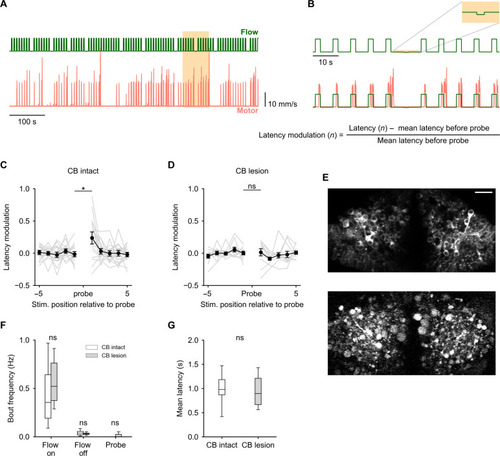Fig. 1
- ID
- ZDB-FIG-240314-18
- Publication
- Narayanan et al., 2024 - Predictive neural computations in the cerebellum contribute to motor planning and faster behavioral responses in larval zebrafish
- Other Figures
- All Figure Page
- Back to All Figure Page
|
The cerebellum uses a learnt expectation of optic flow stimulus to generate swims with lower latency. (A) Optic flow stimulus protocol used (green) and corresponding motor responses of a representative fish (pink). The positions of the probe stimuli were randomized. (B) Zoomed-in view of the highlighted region in (A) Top: A probe stimulus ±5 forward optic flow pulses. Bottom: Calculation of latency modulation around the probe. (C) Average latency modulation for 10 forward optic flow pulses around the probe stimulus. N = 17 fish. Unexpected probe stimuli cause a transient elevation in latency. (D) Latency modulation around the probe stimulus for cerebellum (CB) lesioned fish. N = 11. Probe stimuli did not cause an elevation in latency in lesioned fish. (C) and (D) *P = 0.013; nonsignificant (ns), P > 0.05 by linear mixed-effects evaluating pre-probe versus post-probe latency modulation with an interaction effect of lesion. (E) A single two-photon optical section of the GCaMP6s expressing PCs before (top) and after (bottom) lesioning. Disintegration and blebbing of cells and neuropil can be seen after the lesioning protocol. Scale bar, 20 μm. (F and G) Both lesioned and nonlesioned fish show similar levels of behavioral responsiveness (F) and respond to optic flow with similar average latency (G). ns, P > 0.05 by independent sample t test. |

